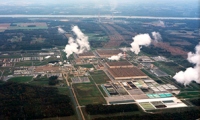Proposal for Paducah laser enrichment plant
26 February 2013
GE-Hitachi subsidiary Global Laser Enrichment (GLE) has formalised a proposal to set up a laser uranium enrichment plant using SILEX technology at the US Department of Energy (DoE)'s Paducah enrichment site in Kentucky.
 |
| Paducah (Image: US DoE) |
GLE submitted an expression of interest including a non-binding proposal for the plant to the DoE on 21 February, SILEX developer Silex Systems Ltd announced in its half-yearly update. GLE is developing and commercialising the SILEX (Separation of Isotopes by Laser Excitation) technology under an exclusive agreement signed with Australian company Silex Systems in 2006, and has been involved in preliminary discussions with DoE about a possible Paducah plant since November 2012.
GLE already has a licence to construct and operate a commercial uranium enrichment plant using SILEX technology at Wilmington in North Carolina: an initial licence decision issued by the US Nuclear Regulatory Commission in September 2012 became final in January 2013. The Wilmington site is already home to GEH's nuclear fuel manufacturing facility. However, Silex Systems claims that it could be significantly quicker and less costly to set up a commercial SILEX laser enrichment facility at Paducah, where existing facilities could be utilised.
The Paducah gaseous diffusion enrichment plant is the oldest operating uranium enrichment plant in the world, but is expected to close down in May 2013 after over 60 years of operations as new US centrifuge capacity comes online. The DoE has been evaluating possible future opportunities for the plant.
Uranium enrichment involves increasing the proportion of the fissile uranium-235 isotope relative to non-fissile uranium-238 for use in nuclear fuels. On a global scale, energy intensive gaseous diffusion technology has now all but been superseded by more energy efficient centrifuge technology. Laser enrichment - sometimes described as third-generation enrichment technology - uses a laser to preferentially excite the uranium-235 in gaseous uranium hexafluoride, making it easier to collect. The process is technically complex but potentially more efficient than centrifuge enrichment technology.
Enrichment produces depleted uranium as a by-product. These depleted uranium 'tails' still contain uranium-235 but at a lower proportion than the approximately 0.7% found in natural, unenriched uranium. Tails therefore could potentially be further processed in an enrichment plant to separate the uranium isotopes further producing a commercially valuable project. Such re-enrichment is likely to be more commercially feasible the more energy efficient the enrichment technology used.
The laser plant proposed for Paducah would potentially process around 115,000 tonnes of high-assay uranium tails inventories owned by the DoE. After re-enrichment, this inventory would be worth around $3 billion, according to Silex Systems.
GLE is continuing test loop operation and engineering design activities at the Wilmington site in preparation for eventual commercialisation of the laser technology. No decision on the construction of a full-scale commercial facility at the North Carolina site has yet been made.
USEC made progress on a demonstration cascade of its indigenously developed American Centrifuge technology, although a commercial facility has struggled to obtain a loan guarantee necessary for the project to proceed. Should GLE decide to construct a laser enrichment plant at Paducah, it may be eligible for that loan guarantee.
Researched and written
by World Nuclear News